American Military Patches, Other Insignia and Decorations of World War Two by Dr. Howard G. Lanham c.2011
Dating Metallic Insignia: Clutch Fasteners
Back of a Pre-WWII Officer's Infantry Tank Insignia. Note the small screw posts and domed retaining nuts
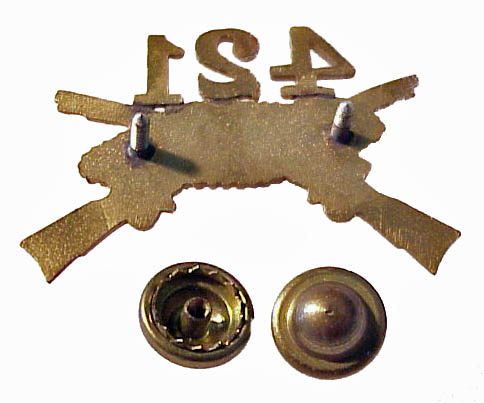
|
|
Back of a Pre-WWII Officer's Infantry Insignia
Note the single screw post and large flat retaining nut
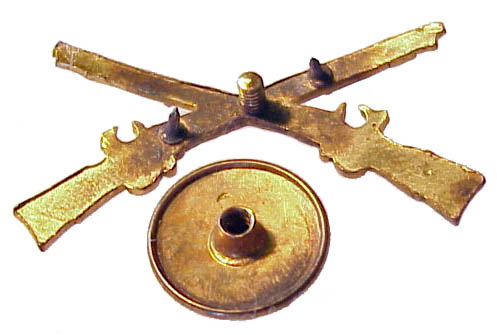
|
|
Back of a Pre-WWII Officer's U.S. Lapel Insignia. Note the screw posts and smaller flat retaining nut.
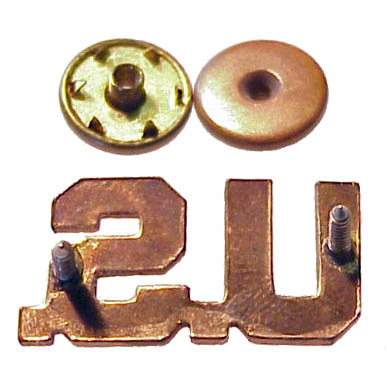
|
|
The Post-World War One period was one of experimentation regarding methods of attaching insignia.
This is a technical discussion of the clutch type fasteners used to attach most modern metallic insignia and familiar to most collectors of 20th Century insignia. When using fasteners to date an insignia there is a risk that someone might have previously removed the original fasteners and replaced them with ones from a different time period. If you are fairly certain that the insignia still has its original fasteners then knowing the time period of the fasteners can be helpful.
There has been a gradual evolution in attaching methods of insignia. In the 19th Century metallic insignia were attached by wire prongs or loops. In the 1890s the first screw back insignia appeared. About the same time pin-back insignia also became more common. Both of these means were commonly used on the large number of insignia produced during the First World War. It was not until after the First World War that the makers of insignia considered if there might be superior means of attaching them. During the war the focus was on producing a volume of insignia to meet the nation's needs. After the war in a market that had suddenly contracted people asked the question can we produce a higher quality insignia that will stand out among the competition? During the 1920s and into the 1930s you begin to see various new kinds of means used to attach insignia other than the familiar screw back posts and pin-backs of World War one. There were a number of small screw posts with small retaining nuts that could be pushed through a fine fabric without doing much damage. The larger screw posts used during World War One left a gaping hole. These smaller screw posts were mostly used in pairs and were on privately purchased officers' insignia. During the Second World War these various screw attachments disappeared from use and were replaced by pointed posts and clutch fasteners.
Phinney Clutches
World War Two Armored Forces Officer's Lapel Insignia with Phinney Clutches and an Amico (American Insignia Co.) mark.

|
It seems that wing badge collectors in particular are fond of reminding others that clutch fasteners existed prior to the Second World War. They are correct about that. However, the truth is that prior to World War Two clutch fasteners were not used on any kind of government-issued, enlisted insignia and were found on a minority of other kinds of privately purchased insignia, mostly worn by officers. The vast majority of pre-World War Two insignia still were pin-back or screw back in construction. I do not believe that I have ever seen a prewar clutch back wing badge but some uncommon examples of them exist. One of the earlier clutch fastener types was the Phinney Clutch that was patented by Elisha A. Phinney of Pawtucket, Rhode Island on May 15, 1923. Phinney was a jeweler by occupation and originally applied for his patent on September 16, 1921. During the 1920s he relocated to Attleboro, Massachusetts where he was working for a manufacturer as a plant foreman. A number of firms that made badges and insignia were located in Attleboro; such as Amcraft (American Metal Crafts Co.) , L. G. Balfour, V. H. Blackinton, and C. M. Robbins. To date I have not been able to establish just who his employer in Attleboro was. I remember Phinney clutches as being common on tie tacks worn in the 1950s and they are sometimes called "tie tack" clutches or "piston type" clutches. Early versions of Phinney clutches are often marked "PAT. APP'D FOR, PAT. MAY 15, 1923 or PAT. NO. 1454857." About the same time as Phinney another inventor Charles Mendler of San Francisco patented another style clutch. Mendler applied for his patent on August 2, 1921 and received patent number 1,413,480 on April 11, 1922. Mendler's fastener was open architecture in design and I have never encountered one being used on an insignia. Even though Mendler received his patent earlier than Phinney, it seems Phinney was better placed to promote his invention. The 1928 Bailey, Banks and Biddle catalog mentions, "Uniform insignia are equipped with pin and safety clasp, screw back or patented clutch fasteners." It appears that clutches were fairly successful in establishing a market rather quickly.
|
|
Phinney Clutch marked "PAT. APP'D FOR" Notice the ding in the center.
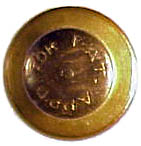
|
|
Phinney Clutch marked PAT. MAY 15, 1923
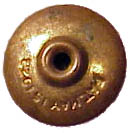
|
|
Phinney Clutch marked PAT. No. 1454857
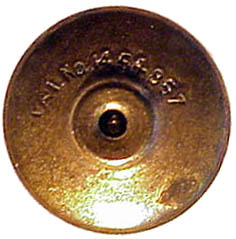
|
|
Silver colored Phinney Clutches
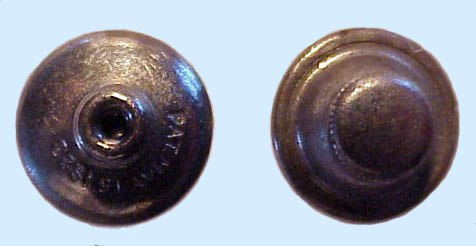
|
Amcraft Clutches
The Back of an Amcraft Coast Artillery Insignia with Later Style Semiplastic Clutches
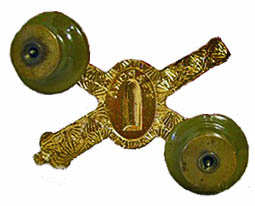
|
|
There are also another two clutch types that are nearly identical to the Phinney clutch. The earlier of these is marked "PAT AMCRAFT PENDING." I have not been able to locate information about Amcraft's patents. The early Amcraft type is distinct in having a raised square frame around the clutch post hole. The later Amcraft insignia are semiplastic in construction. The body is made of olive colored plastic but the piston release is brass. There is a second style of these with a redesigned clutch that has a small hole in the brass piston release that prevents the pointed clutch post from "dinging" the back of the clutch from the inside as is often seen in examples of the Phinney clutch including one above. A third type of clutch, that I am calling a stirrup type, has an identical raised square frame around the clutch post hole to the one marked "PAT AMCRAFT PENDING." Because of that I assume that this one is also an Amcraft product. Unlike most other piston clutches this type is operated by a metal stirrup that protrudes from a hole at the back. It seems that Amcraft did a lot of experimenting with various clutch types on its products.
Founded by Thomas Kelliher, an Irish immigrant, American Metalcrafts Company (Amcraft), Inc. of Attleboro, Massachusetts, formerly the American Emblem & Badge Company, was formed in 1918 and was incorporated in 1923. It produced high quality insignia with a distinctive snow flake pattern on the back as seen in our example. The company was active through World War Two but its insignia disappear in the postwar period.
Early Amcraft Type Clutches with a Squared Front
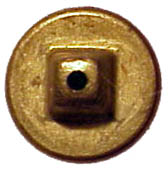
|
|
Back of same marked PAT AMCRAFT PENDING

|
|
Side View of an Early Amcraft Clutch
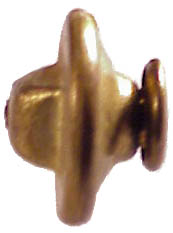
|
|
|
|
Stirrup Type Amcraft Top View
Rather than pulled by a disk this unusual type has a metallic stirrup.
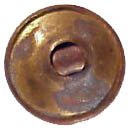
|
|
Stirrup Type Amcraft Side View
This shows the metal stirrup.
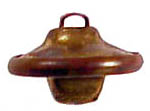
|
|
Stirrup Type Amcraft Angled Side View
Better Showing the Stirrup
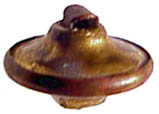
|
|
|
|
Late Amcraft Semiplastic Front View
This looks the same both kinds.
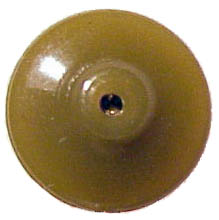
|
|
Late Amcraft Semiplastic Nonperforated Back View
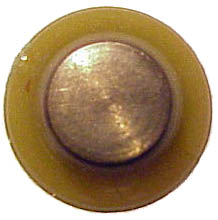
|
|
Late Amcraft Semiplastic Perforated Back View
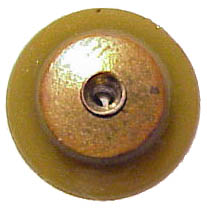
|
|
Late Amcraft Semiplastic Perforated Side View
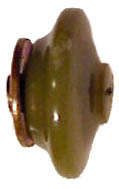
|
|
Ballou Clutches
View of Ordnance Officer's Insignia with Ballou Clutches
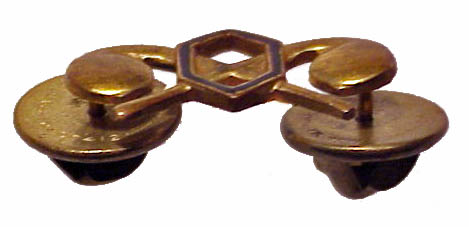
|
|
View of the Back Intelligence Officer's Insignia with Ballou Clutches

| |
At the onset of World War Two the majority of insignia were being attached by pins or screws. However, by the end of the war it is possible the percentage attached by clutches exceeded those attached by those older means. The success of clutches was mostly the result of the introduction of the Ballou clutch in 1942. The clutch was invented by Frederick A. Ballou, Jr. and Melvin Moore. The B. A. Ballou Company of East Providence, Rhode Island began producing clutches in 1942, having applied for its patent on May 13, 1942. It received patent number 2,308,412 for a securing device on January 12, 1943. The firm was founded as a jewelry business by Civil War veteran Barton Allan Ballou 1835-1922 and was incorporated in 1910. His son Frederick Allen Ballou 1869-1947 became president of the company after his father's death and his grandson Frederick Allen Ballou, Jr., a Brown University Graduate and a World War One veteran, also entered the business and was one of the inventors of the clutch. The invention of the Ballou clutch occurred just at the right moment. It was make of light weight stamped brass at a time the military was interested in conserving brass. The Ballou Company produced 300 million clutches during the war and earned an Army-Navy Efficiency Award as a result. Clutches were used by all services and on many different categories of insignia. They were used on officer and enlisted lapel insignia, wing badges, other qualification badges, and ribbon bars. During the Second World War rank insignia and distinctive insignia continued to be mostly of pin-back or screw back construction but after the war Ballou clutches also because common place on them. There is an issue of the National Geographic Magazine dated December 4, 1944 that discusses insignia and is familiar to most collectors. This article includes a photograph of a female worker assembling ribbon bars using Ballou clutches on page 55. Ballou continued to improve its clutch and got a new patent, Number 2551196, on July 29,1948. The improved clutch has eight cleats in four groups of two on the surface to better grip the material. In time Ballou's various patents expired and other companies began producing clutches similar to Ballou's. Although Ballou was a jeweler, the company did not seem to be a major producer of insignia, as most of the marked insignia using Ballou clutches were manufactured by other companies. The W.R. Cobb Company acquired the B.A Ballou company in 2009 and it still exists today as a subsidiary but is no longer a family run business.
Chronology of Ballou Type Clutches
| Year
| Type
| Manufacturer
| Marking
| Image
| Notes
|
| 1942
| Plain
| Ballou
| Patent Pending *
| 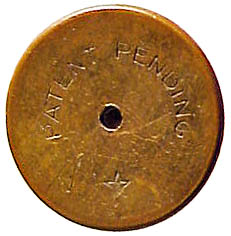
| brass 12.5mm
|
| 1942
| Plain
| Ballou
| Patent Pending Sterling *
| 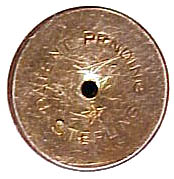
| silver 12.5mm
|
| 1943
| Plain
| Ballou
| Pat Nos 2308412 2308424
| 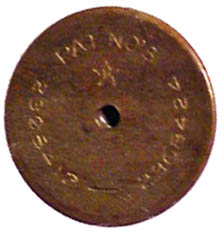
| brass 12.5mm
|
| 1943
| Plain
| Ballou
| Pat Nos 2308412 2308424
| 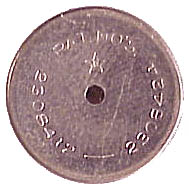
| silver colored 12.5mm
|
| 1943
| Plain
| Ballou
| Sterling Pat Nos 2308412 2308424
| 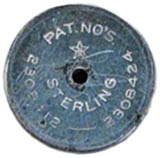
| silver colored 12.5mm
(Courtesy: Fred G. Rush, 3rd)
|
| c 1945
| 4 Cleats
| Ballou
| Pat Nos 2308412 2308424 B in Star
| 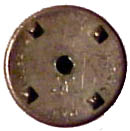
| silvered colored 10mm
|
| c 1947
| 8 Cleats
| Ballou
| Pat Nos 2308412 2308424 B in Star
| 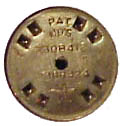
| brass 12.5mm
|
| c 1947
| 8 Cleats
| Ballou
| Pat Nos 2308412 2308424 B in Star
| 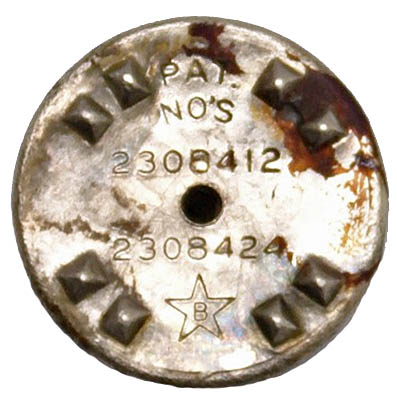
| silver colored 12.5mm
(Courtesy: Pieter Oosterman)
|
| 1948
| 8 Cleats
| Ballou
| Pat Nos 2308412 2308424
| 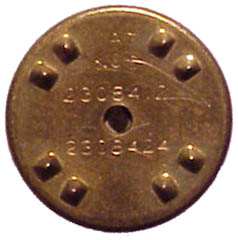
| brass 12.5mm
|
| 1948
| 8 Cleats
| Ballou
| Pat Nos 2308412 2308424
| 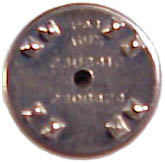
| silver colored 12.5mm
|
| 1951
| 8 Cleats
| Ballou
| Pat Nos 2308412 2308424 2551196
| 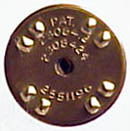
| brass 12.5mm
|
| Unknown
| Plain
| Unknown
| None
| 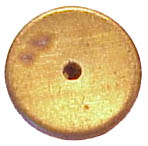
| brass 12.5mm generic post-patent
or early prototype?
|
| Unknown
| 4 Cleats
| Unknown
| None
| 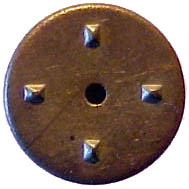
| brass 12.5mm
|
| Unknown
| 4 Cleats
| Unknown
| None
| 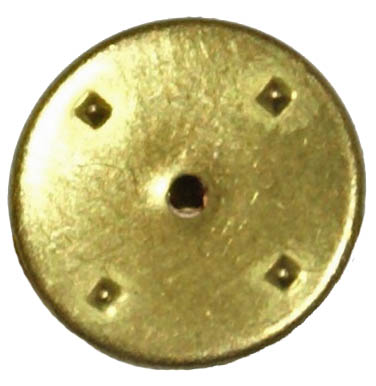
| brass 12.5mm
(Courtesy: Pieter Oosterman)
|
| after 1955
| 8 Cleats
| Ballou
| Ballou Reg'd
| 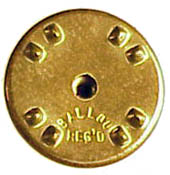
| brass 12.5mm
|
| after 1955
| 8 Cleats
| Ballou
| B.A.B. Reg'd
| 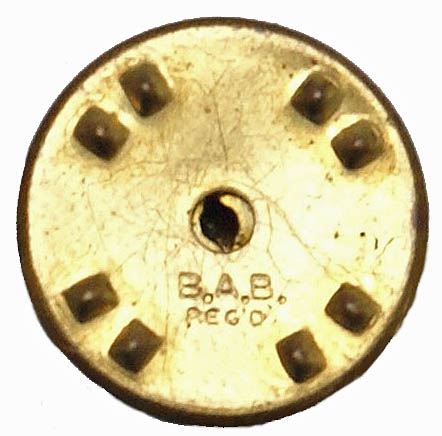
| brass 12.5mm
(Courtesy: Pieter Oosterman)
|
| after 1955
| 8 cleats
| Unknown
| Improved Clutch
| 
| brass 12.5mm
|
| after 1955
| 8 cleats
| Unknown
| Improved Clutch Japan
| 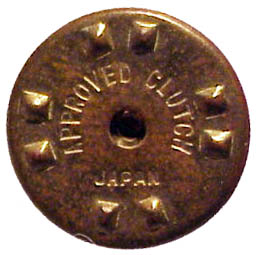
| brass 12.5mm
Imported by Denmark Military Co., NY
|
| after 1955
| 8 cleats
| Unknown
| Hermes
| 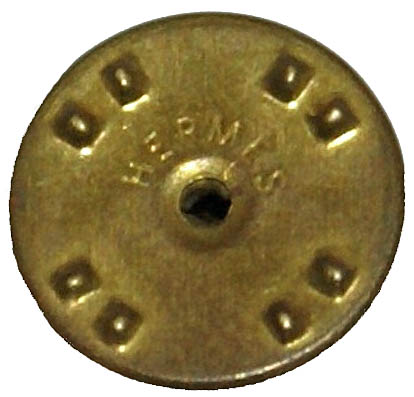
| brass 12.5mm
(Courtesy: Pieter Oosterman)
|
| after 1955
| 8 cleats
| Unknown
| None
| 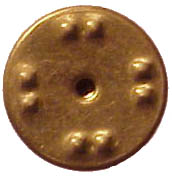
| brass 12.5mm
|
| c 1960s
| 8 Cleats
| Unknown
| Made in USA
| 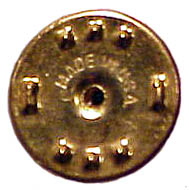
| brass 12.5mm
|
| c 1960s
| 8 Cleats
| G.T. Jandy
| Jandy Reg
| 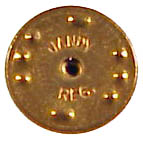
| brass 12.5mm
|
| c 1960s-1996
| 8 Cleats
| Unknown
| Hermes
| 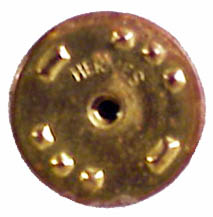
| brass 12.5mm
|
| c 1970s-1996
| 8 Cleats
| His Lordship's Products
| Lordship N.Y.
| 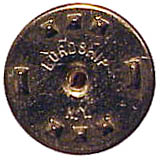
| brass 12.5mm
|
| c 1970s
| 8 Cleats
| Ira Green, Inc
| Ira-Green, Inc
| 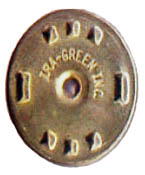
| brass 12.5mm
|
| c 1970s
| 8 Cleats
| Unknown
| Metal City
| 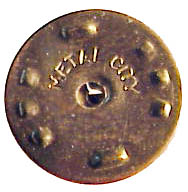
| brass 12.5mm
|
| c 1970s
| 8 Cleats
| N. S. Meyer, NY
| N.S. Meyer
| 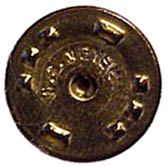
| brass 12.5mm
|
| c 1970s
| 8 cleats
| Unknown
| None
| 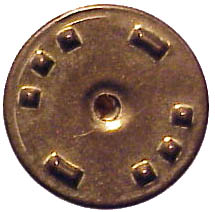
| brass 12.5mm
|
| c 2000
| 8 Cleats
| Ballou
| Ballou Reg't 130 years
| 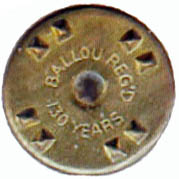
| brass 12.5mm
|
The more recent dates that I give are subject to error and are mostly estimates of my part. The older Ballou clutch dates are based on the patent dates and expirations or were provided by Frederick A. Ballou, Jr. himself in his correspondence with me back in 1970.
Tinnerman Clutches
World War Two Tinnerman Clutchs
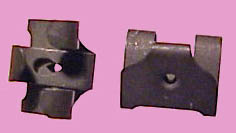
|
A second, less common clutch type found on some World War Two era insignia are Tinnerman clutches. These were invented by Albert H. Tinnerman (1879-1961), whose company made all kinds of spring steel fasteners for industrial applications. Some of the newer Tinnerman clutches are marked with individual numbers and have a silver finish.
Rex Clutches
Rex Clutch marked Patent Pending Rex
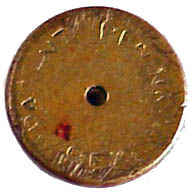
|
|
Rex Clutch Side View
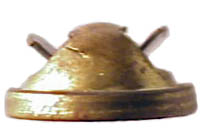
|
|
Rex Clutch
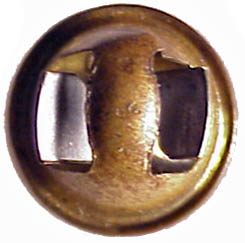
| |
A third, even less common clutch type found on some World War Two era insignia are Rex clutches. The inventor of the Rex clutch was Frank Winters, who assigned his invention to the Rex Products Corporation of New Rochelle, N.Y. The patent was applied for on December 18, 1942 but not granted until April 3, 1945 as patent number 2,372,922. Examples of the clutches are marked "Patent Pending Rex."
Thanks to Jay Graybeal and Pieter Oosterman for their assistance with this article.
"Ball Type" Clutches
"Ball Type" Clutches marked Patent Pending
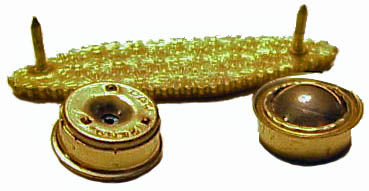
|
|
"Ball Type" Side View

|
|
A fourth, very unusual clutch type found on a pair of World War Two era armored forces insignia I am nicknaming "ball type" clutches until I discover more about them. They are marked "patent pending." I cannot he absolutely certain the clutches are original to the insignia but they are part of a pair that appear to be unused and all four of the clutches are of this type. The background and inventor of these clutch is unknown but the armored forces insignia have a typical snow flake pattern typical of Amcraft. Most Amcraft manufactured insignia have other types of clutches and this type does not appear to offer any particular advantage. It is uncertain if these clutches are of Amcraft manufacture themselves.
Assmann Clutches
Assmann Clutch marked with Assmann hallmark and AHA D.B.P.o.
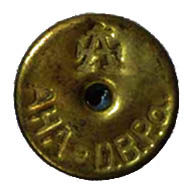
|
|
Assmann Clutch
Three-Quarter View
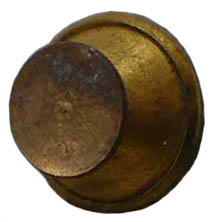
|
|
Following the Second World War U.S. Army insignia were manufactured in Europe. The Assmann company was a leading German manufacturer and developed a clutch rather similar to Phinney 's.
A special thanks to Jay Graybeal for his assistance with this article.
References:
- Correspondence: Frederick A. Ballou, Jr. and H. G. Lanham 1970
- Emerson, William K., Encyclopedia of United States Army Insignia and Uniforms, Norman, OK: University of Oklahoma Press, 1996.
- Grosvenor, Gilbert et al., Insignia and Decorations of the U.S. Armed Forces, Washington: National Geographic Society, 1944.
- Laframboise, Leon W., History of the Administrative and Technical Services Branch of Service Insignia, El Paso: (Privately Printed), 1968.
- Lanham, Howard G., "Method for Approximating Date of Metallic Insignia", The Trading Post, July-September 1970: 74.
- Military Forum Discussion: Clasps and Fasteners - What's Right?
- Military Forum Discussion: Enlisted Collar Disks "Type IV"
- Scipio, L. Albert II The Collar Disk Story (1907-1999), Silver Spring, MD: (Privately Printed), 1999.
- War Department, Army Regulations No. 600-35: Prescribed Service Uniform, Washington, DC: Government Printing Office, 1941.
- War Department, Army Regulations No. 600-35: Prescribed Service Uniform, Washington, DC: Government Printing Office, 1944.
Back to Enlisted Branch Insignia of World War Two
Back Dating Various Categories of Insignia to period of use.
Back to Insignia of World War Two
































